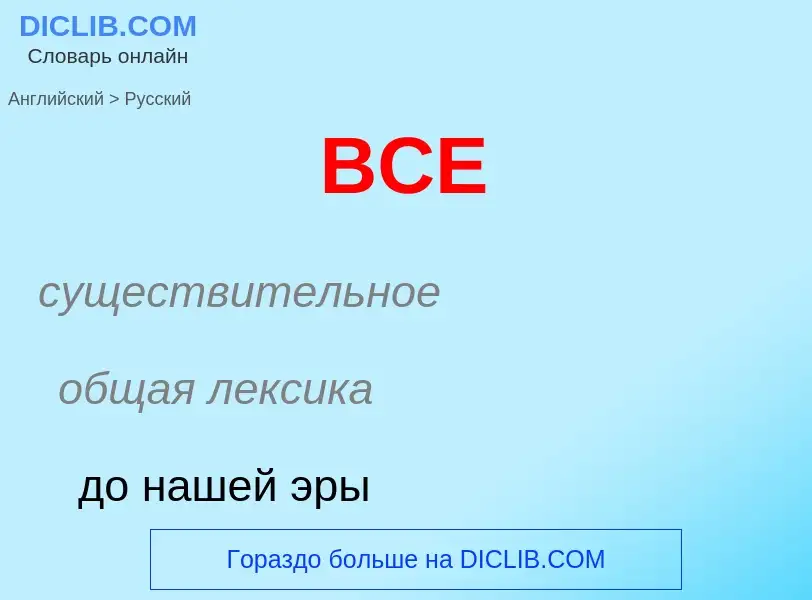Перевод и анализ слов искусственным интеллектом ChatGPT
На этой странице Вы можете получить подробный анализ слова или словосочетания, произведенный с помощью лучшей на сегодняшний день технологии искусственного интеллекта:
- как употребляется слово
- частота употребления
- используется оно чаще в устной или письменной речи
- варианты перевода слова
- примеры употребления (несколько фраз с переводом)
- этимология
BCE - перевод на русский
существительное
общая лексика
до нашей эры
синоним
[kɔmən'i(ə)rə]
общая лексика
наша эра
новая эра
[pæliə'liθik]
прилагательное
общая лексика
палеолитический
существительное
[pæliə'liθik]
общая лексика
(Paleolithic) эпоха палеолита
[əuld'stəuneidʒ]
геология
палеолит
древний каменный век
[pæliə'liθik]
прилагательное
геология
палеолитический
Определение
Википедия
Common Era (CE) and Before the Common Era (BCE) are year notations for the Gregorian calendar (and its predecessor, the Julian calendar), the world's most widely used calendar era. Common Era and Before the Common Era are alternatives to the original Anno Domini (AD) and Before Christ (BC) notations used for the same calendar era. The two notation systems are numerically equivalent: "2023 CE" and "AD 2023" each describe the current year; "400 BCE" and "400 BC" are the same year.
The expression can be traced back to 1615, when it first appears in a book by Johannes Kepler as the Latin: annus aerae nostrae vulgaris (year of our common era), and to 1635 in English as "Vulgar Era". The term "Common Era" can be found in English as early as 1708, and became more widely used in the mid-19th century by Jewish religious scholars. Since the later 20th century, BCE and CE have become popular in academic and scientific publications because BCE and CE are religiously neutral terms. They are used by others who wish to be sensitive to non-Christians by not referring to Jesus, the center figure of Christianity, especially via the religious terms "Christ" and Dominus ("Lord") utilized by the other abbreviations.

![[[Johannes Kepler]] first used "Vulgar Era" to distinguish dates on the Christian calendar from the [[regnal year]] typically used in national law. [[Johannes Kepler]] first used "Vulgar Era" to distinguish dates on the Christian calendar from the [[regnal year]] typically used in national law.](https://commons.wikimedia.org/wiki/Special:FilePath/JKepler.jpg?width=200)


![bands]] for rare commodities and raw materials (such as stone needed for making tools) as early as 120,000 years ago in Middle Paleolithic. bands]] for rare commodities and raw materials (such as stone needed for making tools) as early as 120,000 years ago in Middle Paleolithic.](https://commons.wikimedia.org/wiki/Special:FilePath/Arrowhead.jpg?width=200)
.jpg?width=200)
![[[Gwion Gwion rock paintings]] found in the north-west [[Kimberley region of Western Australia]]. [[Gwion Gwion rock paintings]] found in the north-west [[Kimberley region of Western Australia]].](https://commons.wikimedia.org/wiki/Special:FilePath/Bradshaw rock paintings.jpg?width=200)
![[[Charles R. Knight]]'s 1920 reconstruction of Magdalenian painters at [[Font-de-Gaume]], France [[Charles R. Knight]]'s 1920 reconstruction of Magdalenian painters at [[Font-de-Gaume]], France](https://commons.wikimedia.org/wiki/Special:FilePath/Font-de-Gaume.jpg?width=200)
![Picture of a half-human, half-animal being in a Paleolithic [[cave painting]] in [[Dordogne]]. France. Some archaeologists believe that cave paintings of half-human, half-animal beings may be evidence for early shamanic practices during the Paleolithic. Picture of a half-human, half-animal being in a Paleolithic [[cave painting]] in [[Dordogne]]. France. Some archaeologists believe that cave paintings of half-human, half-animal beings may be evidence for early shamanic practices during the Paleolithic.](https://commons.wikimedia.org/wiki/Special:FilePath/Gabillou Sorcier.png?width=200)
![A skull of early ''[[Homo neanderthalensis]]'', [[Miguelón]] from the [[Lower Paleolithic]] dated to 430,000 bp. A skull of early ''[[Homo neanderthalensis]]'', [[Miguelón]] from the [[Lower Paleolithic]] dated to 430,000 bp.](https://commons.wikimedia.org/wiki/Special:FilePath/Homo heidelbergensis. Museo de Prehistoria de Valencia.jpg?width=200)


![The [[Venus of Willendorf]] is one of the most famous Venus figurines. The [[Venus of Willendorf]] is one of the most famous Venus figurines.](https://commons.wikimedia.org/wiki/Special:FilePath/Wien NHM Venus von Willendorf.jpg?width=200)

